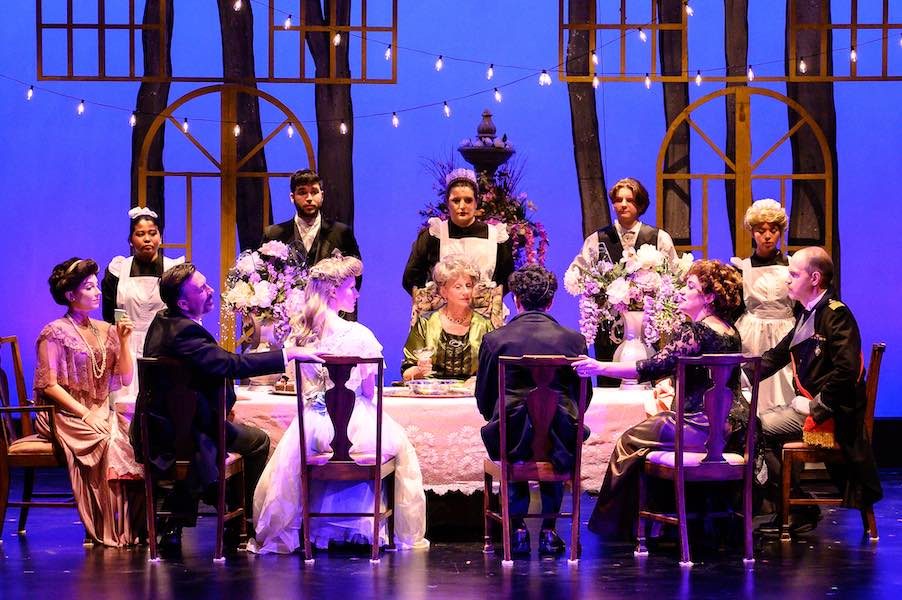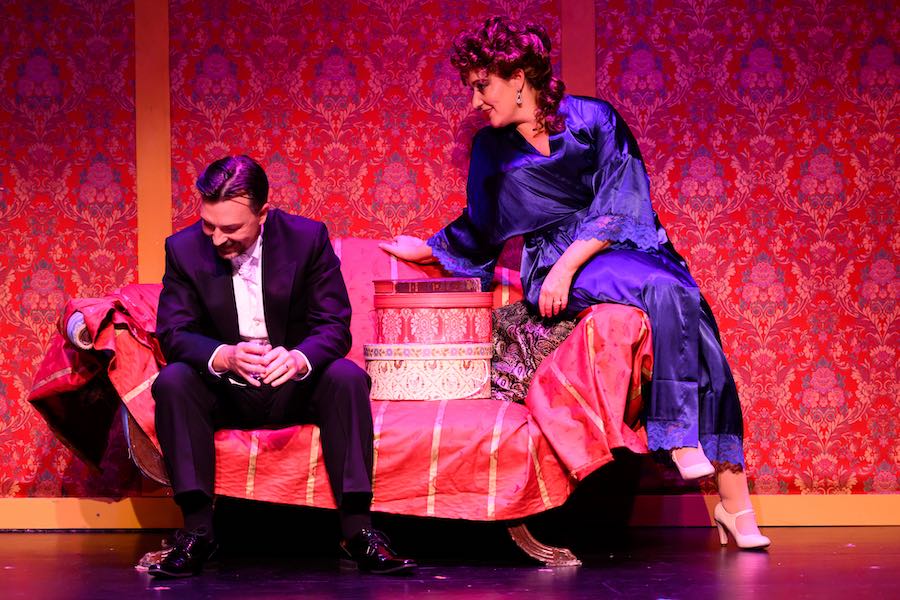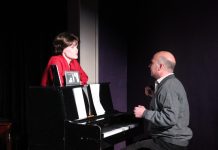Based on Smiles of a Summer Night, the great Swedish film director Ingmar Bergman’s only comedy, A Little Night Music stands as Stephen Sondheim’s closest approach to a rom-com, albeit one with the psychological complexity and shades of darkness for which Sondheim is justly famous. The story follows interlocking, mismatched couples as, somewhat in spite of themselves, they grope their way toward the relationships they truly desire.
The vocal quality of the Reston Community Players cast is superb, starting with the quintet (Richard Jacobson, Claudia Barbish, Nour Bahri, Alden Michaels, and Amanda Jones), who open the show with its sung overture and, as a sort of Scandinavian Greek chorus, frequently comment on characters, situations, and, in one of their best moments, the oddity of living in the land of the midnight sun. If one had to name the brightest star among an excellent cast, the quintet would be it. To director Andy Regiec’s credit, he gives members of the quintet some brief, effective acting moments, an opportunity that many productions miss.

As that exemplar of toxic masculinity, Count Malcolm, baritone James Rogers provides the most spectacular performance of “In Praise of Women” I’ve ever heard, sustaining the song’s final note to the audience’s acclaim. As a comic actor, Rogers succeeds by allowing his character to take himself very seriously at all times, never betraying any awareness of how ridiculous he is.
Among the younger characters, Shakil Azizi as Henrik is convincing in his late teenage angst and emotionally volatility, combined with mastery of the wide-ranging vocal gymnastics of his first act song, “Later.” As his counterpart, Anne, Shelby Young has the pure, high soprano sound needed for her ingénue role, first on display in “Soon.” Young handles well Anne’s second act awakening to the fact that she has real feelings to act upon, beyond the frivolousness she has used to keep them at bay.
The lead couple, Fredrik and Desirée (Joshua and Jennifer Redford), are long-ago lovers who dance tentatively around one another, yearning for reconnection yet not, until almost too late, directly confronting what they feel. This creates good opportunities for comedy, as in their first act number, “You Must Meet My Wife.” It also leads to the best-known song in the show, Desirée’s “Send in the Clowns,” in which she contends, in a mood of rueful resignation, with crushed hopes. Veteran actress that Desirée is, she does so in poignant theatrical metaphors.

Sondheim wrote the song, with its narrow range and short phrases, for the original Desirée, Glynnis Johns, an actor with very limited singing ability. It is best presented absolutely straight. When a good singer, like Redford, does the number, it can be hard to avoid a few vocal interpretive touches that depart from the song’s powerful simplicity.
Perhaps the show’s most complex character is Charlotte, Count Malcolm’s conflicted and much put-upon wife, who has a love-hate relationship not only with her husband but with her own sexuality. Mel Gumina sings her song, “Every Day a Little Death,” capably, though there are some psychological depths in the character she doesn’t quite reach.

Sue Pinkman is probably the most ambulatory Madame Armfeldt (Desirée’s acerbic, elderly mother) I’ve ever seen, rising from her wheelchair to move about during most of “Liaisons,” her lament about the insistence of younger generations for forming relationships based on love rather than worldly gain. In one of the show’s best lines, she refers to sex as but “a pleasurable means to a measurable end.” Her consistent vigor makes her last-minute instant death — an aspect of the show that has never worked in any production I’ve seen or participated in — even less credible than usual.
Interestingly, Sondheim gives what used to be called the “11 o’clock number” to a relatively minor character, Anne’s maid Petra. Cody Boehm gives a rousing rendition of “I Will Marry the Miller’s Son,” an anthem to the playful enjoyment of carnality combined with melancholy about the limits of opportunities for lower-class women.
The show’s successful ensemble singing is not limited to the quintet, with complicated numbers like the first-act counterpart trio among Fredrik, Anne, and Henrik and the wondrous first-act finale, “A Weekend in the Country,” being prime examples. Lucia LaNave deserves credit not only for the production’s vocal virtues but the playing of the orchestra, which generally grappled well with Sondheim’s always-challenging score.
Regiec keeps the complex relationships among the ensemble cast clear, adding some lovely details I haven’t seen in other productions, such as not only Count Malcolm but Fredrik and his party arriving at Madame Armfeldt’s estate in their motorcars, as befitting male rivals trying to one-up each other. Phillip Smith-Cobbs’ choreography, above all in the opening quintet and “Night Waltz” sequences, is graceful and flowing, in keeping with the mood and ¾ time signature of the score.
The set, designed by Regiec and Skip Gresko, relies primarily on a wide variety of small pieces, like furniture and trees, being wheeled or pushed on and off stage by cast members. Given the number of scene changes in the show, this process cumulatively adds to the production’s lengthy running time. There is also extensive use of the theater’s fly space, with the flown-in outlines of Madame Armfeldt’s estate being a nice touch.
Hugh Wheeler’s 1973 book has not aged as well as Sondheim’s music, and to audiences accustomed to the more sung-through musicals of more recent years (including many of Sondheim’s), some of the dialogue scenes may feel a bit slow. But that it is easy to forgive given the vocal splendors of Reston Community Players’ production. Whether for first-time viewers or longtime Sondheim fans, the singing here is not to be missed.
Running Time: Three hours, including one intermission.
A Little Night Music plays through October 30, 2022 (at 8 pm on October 15, 21, 22, 28, and 29 and at 2 pm on October 23 and 30) presented by Reston Community Players performing at the Reston Community Center, 2310 Colts Neck Road, Reston, VA. Tickets ($30 for adults and $25 for juniors and seniors) may be obtained online, from Reston Community Players at 703-476-4500, or in person at the Reston Community Center’s box office.
The playbill for A Little Night Music is online here.
COVID Safety: Masks covering mouth and nose are worn by all persons while inside the Reston Community Center regardless of vaccination status, at the request of the Reston Community Players.





I have to say I felt the strength of the individual performances by just about everyone (and in particular the Greek chorus) (although the male lead Joshua seemed uninspired) carried this show. The director on the other hand likely ruined what could have been a masterful show with his heavy handedness and direction at times. I wish a more competent director was at the helm of this show.
This is a very good production with solid performances, nimble scenery and gorgeous costumes, and yes, splendid vocals. Go see it. Among the cast, Mr. Azizi’s Henrik captures his youthful angst. Ms. Young’s Anne manages some moments that can be very difficult to pull off (“when you’re close and we touch;” “how comical you look”), and conveys tenderness towards Henrik in the final scenes, when the character’s cartoonish aspects can easily overshadow her new found emotions. And her tone when expressing hope that the horses are “smart” points to an immaturity that may doom her elopement–perhaps a premonition of the night smiling for the young who know nothing (I loved it!). Ms. Gumina also manages some moments that can be difficult to pull off (“I’ll tell you why” just before “Every Day A Little Death;” and her reaction to her husband’s defense of her virtue at the end, when her newfound tenderness toward her husband can be difficult to portray after scenes that foreground her brittleness). Ms. Redford’s “Send In the Clowns” is just about perfect, alternating, as it should, between bemusement, self-knowledge, affection, and grief. The cars are a nice touch and give Fredrik and Carl-Magnus another opportunity to highlight their rivalry (though this is not the first production to show the cars). And yet. The lighting design bathes the performers in a lurid hot pink in some scenes. And the direction leans strongly towards the semaphoric, with the performers evidently having been instructed to pantomime every single line and lyric, which gets tiresome. Irritating, too, when the gestures have nothing to do with the words–a male member of the quintet indicates large breasts, while singing about the “lady with the large…tambourine.” Another example: Fredrik’s own moment of self-recognition, in a reference to King Lear (a fool with a challenging daughter), imitates a sword thrust, which has nothing to do with the allusion. Also, Frid’s loud snoring at the end of “Miller’s Son,” which upstages a fine rendition of the song. Yes, Mme Armfeldt is pretty ambulatory, but some actors have performed “Liaisons” while in the wheelchair, some while leaning on a cane (Zarah Leander, Margaret Hamilton, Florence Lacey). Her death was oddly staged, though it is possible to do it gracefully. More importantly, I think there was a missed opportunity to foreground the character’s tragedy. And they could have used a dramaturge, or at least someone who has seen “Downton Abbey” (garlands of lights at dinner; some aspects of some performances that seemed much too contemporary, like “air quotes” at one point; and mugging and grinning servants). The piece has been described as a melancholy farce. That’s a difficult balance to strike, but powerful if done well. The preference toward guffaws when a knowing smile would be sufficient betrays a lack of trust in the material. Still, well worth seeing.
While “A Little Night Music” has been recognized for the integration of its book and lyrics, it is true that some elements have not aged well. In particular, in the era of “Me, Too,” some rethinking (in terms of performance or staging), appears overdue for the following: Fredrik’s reference to “physical force” in “Now” (though the character rejects that option); in “Remember,” members of the quintet sing “And ah, how I lied,” and “You acquiesced, and the rest is a blank;” and Fredrik and Carl-Magnus’ imagining that if Desiree had only been “bruised” (among a number of other things), her allure could have been more easily dismissed (though the men’s cluelessness here is precisely the point). There may be ways to stage or interpret these to update them for contemporary audiences while maintaining artistic integrity and fidelity to the period. One production in Baltimore, for example, featured a judicious slap by one of the women of the quintet in response to the objectionable lyrics.